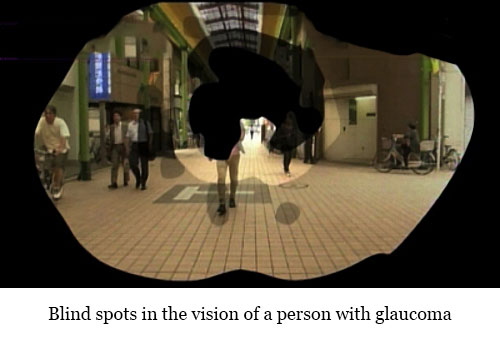Driving with glaucoma? Some patients increase scanning to adapt for impaired vision
Some people with glaucoma-related binocular (both eyes) vision loss can pass a standard driving test by adopting increased visual scanning behavior, reports a study in the October issue of Optometry and Vision Science, official journal of the American Academy of Optometry. The journal is published by Wolters Kluwer.
Increased scanning—particularly more frequent head and eye movements - was a key strategy to compensate for visual impairment due to glaucoma, reports the study by Enkelejda Kasneci, PhD, of University of Tübingen, Germany, and colleagues. “Like most people, many glaucoma patients with binocular peripheral visual field loss can make useful adaptations for their condition,” comments Anthony Adams, OD, PhD, Editor-in-Chief of Optometry and Vision Science.
Drivers with Glaucoma Adapt by Moving Their Eyes and Head
In a state-of-the-art virtual reality driving simulator at a Mercedes-Benz technology center, six patients with glaucoma and binocular vision loss performed a simulated driving test. With real acceleration, 360-degree visual projection, and a real car body, the moving-base simulator provided a “close-to-realistic driving experience.”
During the 40-minute test, drivers encountered various traffic situations and nine different hazardous situations - for example, pedestrians suddenly appearing behind parked cars or risky passing maneuvers by oncoming cars. Subjects who failed any of the nine hazardous situations failed the driving test.
Eight subjects with normal vision were studied for comparison. In both groups, sophisticated measures of the subjects’ eye- and head-tracking movements were obtained and compared with performance on the driving simulation.
 Three of the six glaucoma patients passed the driving test, with performance indistinguishable from that in subjects with normal vision. Compared to patients who failed, passing drivers showed “increased visual exploration”- they made more head movements and more eye movements.
Three of the six glaucoma patients passed the driving test, with performance indistinguishable from that in subjects with normal vision. Compared to patients who failed, passing drivers showed “increased visual exploration”- they made more head movements and more eye movements.
The successful drivers changed fixation (where they looked) more often, and had shorter fixation times than those who failed the driving test. “Such behavior indicates an increased scanning activity in glaucoma patients who passed,” Dr. Kasneci and coauthors write.
In contrast, glaucoma patients who failed the driving test had reduced head and eye movements, with a tendency to a more straight-ahead eye position. Patients who passed the driving test also drove more slowly—perhaps giving them more time to visually scan their environment.
The pilot study was limited by the small number of patients - reflecting the complexity and cost of testing in the virtual reality simulator. Although vision loss varied, all of the glaucoma patients would be ineligible for a driver’s license in many European countries because of their binocular visual field defects. In other countries, and in some US states, patients with binocular visual field loss can be granted a driver’s license after passing an on-road test.
The results add new evidence on the “compensatory gaze strategies” that some patients adopt to help them drive safely despite binocular vision loss. Dr. Adams adds, “For these patients, their successful adaptations appeared to involve making increased numbers of head and eye movements to the location of objects in what would normally be their peripheral vision.”
“This type of compensation improves traffic safety and may have practical implications in planning individualized driving fitness tests and driver rehabilitation programs,” Dr. Kasneci and colleagues conclude. They recommend more individualized driving assessments, taking into account the patient’s ability to compensate for binocular visual field loss.
###
Click here to read “Driving with Glaucoma: Task Performance and Gaze Movements.”
Article: “Driving with Glaucoma: Task Performance and Gaze Movements” (doi: 10.1097/OPX.0000000000000702)
About Optometry and Vision Science
Optometry and Vision Science, official journal of the American Academy of Optometry, is the most authoritative source for current developments in optometry, physiological optics, and vision science. This frequently cited monthly scientific journal has served primary eye care practitioners for more than 75 years, promoting vital interdisciplinary exchange among optometrists and vision scientists worldwide.
About the American Academy of Optometry
Founded in 1922, the American Academy of Optometry is committed to promoting the art and science of vision care through lifelong learning. All members of the Academy are dedicated to the highest standards of optometric practice through clinical care, education or research.
About Wolters Kluwer
Wolters Kluwer is a global leader in professional information services. Professionals in the areas of legal, business, tax, accounting, finance, audit, risk, compliance and healthcare rely on Wolters Kluwer’s market leading information-enabled tools and software solutions to manage their business efficiently, deliver results to their clients, and succeed in an ever more dynamic world.
Wolters Kluwer reported 2014 annual revenues of €3.7 billion. The group serves customers in over 170 countries, and employs over 19,000 people worldwide. The company is headquartered in Alphen aan den Rijn, the Netherlands. Wolters Kluwer shares are listed on NYSE Euronext Amsterdam (WKL) and are included in the AEX and Euronext 100 indices. Wolters Kluwer has a sponsored Level 1 American Depositary Receipt program. The ADRs are traded on the over-the-counter market in the U.S. (WTKWY).
###
Connie Hughes
Connie.Hughes@wolterskluwer.com
646-674-6348